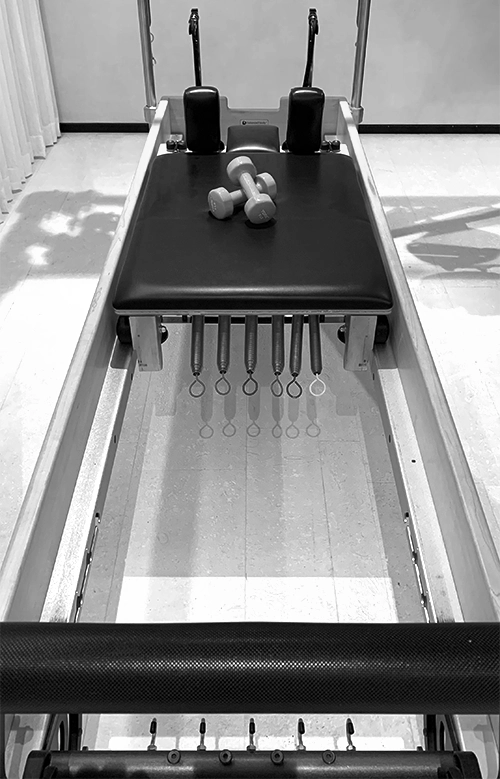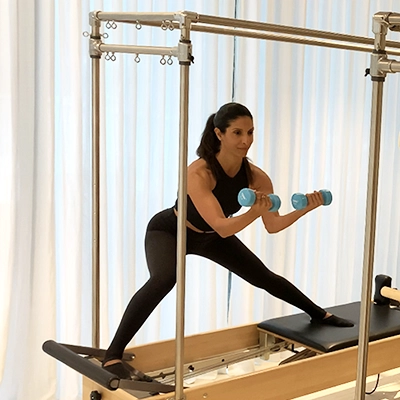As a dedicated Pilates instructor, I’ve seen a notable shift in the Pilates scene that is hard to ignore. Traditional Pilates is merging with other workouts, especially weight training. Finding a pure Pilates class is becoming a challenge. In this exploration, I aim to highlight these changes and reflect its impact on my role and on Pilates itself.
Pilates vs Weight Training
In the “Pilates vs. weight training” debate, the differences are significant. Core strength, flexibility, and awareness are enhanced by Pilates, which also improves posture and coordination. Meanwhile, weight training targets muscle tone and strength for growth and endurance. Knowing these differences helps choose the right exercise for one’s fitness goals, be it Pilates’ holistic benefits or weight training’s muscle-building.
To better understand the Pilates method vs weight training, let’s reexamine the foundational principles of Pilates, embracing its unique contributions to holistic well-being.
Pilates, envisioned by Joseph Pilates in the early 20th century, is a holistic fitness approach anchored in six fundamental principles: breathing, centering, concentration, control, precision, and flow. These principles serve as the cornerstone of Pilates, guiding practitioners towards a mind-body connection and improved physical awareness.
Revisiting Pilates Principles:
- Breathing: Central to Pilates is the emphasis on conscious and coordinated breathing. By synchronizing breath with movement, practitioners enhance oxygen flow, engage the diaphragm, and promote relaxation.
- Centering: Pilates centers around the core, often referred to as the powerhouse. Strengthening the core muscles provides a stable foundation for movement, fostering balance and stability.
- Concentration: The mindful engagement of the mind during Pilates is essential. Concentration directs focus to each movement, promoting precision and preventing the mind from wandering.
- Control: Pilates exercises are executed with precision and control. Movements are deliberate, emphasizing quality over quantity, which enhances muscle engagement and prevents strain.
- Precision: Attention to detail is paramount in Pilates. Precision ensures that each movement is executed with accuracy, targeting specific muscles and promoting optimal alignment.
- Flow: The seamless flow of movements distinguishes Pilates. By maintaining a continuous, controlled flow, practitioners enhance flexibility, coordination, and overall grace.
These traditional Pilates principles seem to be fading as instructors blend in weight training. While this mix offers benefits, it’s changing the essence of Pilates. The focus on breath, control, and precision is becoming less prominent. As these changes unfold, it’s crucial to maintain the core principles that make Pilates unique, ensuring its holistic well-being benefits aren’t overshadowed by the integration of weight training elements.

Can Pilates Replace Weight Training?
While Pilates undoubtedly contributes to muscle strength, it is not intended to replace weight training for those seeking maximal muscle strength and heavy lifting capabilities. Pilates and weight training can both be part of a good fitness plan, and each one offers its own unique benefits.
Ultimately, the choice between Pilates and weight training depends on your fitness goals. If you’re primarily interested in improving core strength, flexibility, and body awareness, Pilates may be the better choice. If you’re looking to build muscle, increase metabolism, and enhance overall strength, weight training may be more suitable.
For a balanced fitness regimen, many people (including myself) combine both. Pilates can complement weight training by enhancing core strength, flexibility, and muscle endurance, which can benefit your performance in weight training.
I imagine it as a tag team – Pilates sets the stage, working on flexibility and core strength, and then weight training takes it up a notch, sculpting muscles and giving you that extra push. It’s not just about looking good; it’s about feeling amazing, having functional strength, and keeping your joints happy.

Pilates vs Weight Training- Which is better to shape and sculpt the body?
Although my primary emphasis lies in highlighting the health benefits of fitness, I acknowledge that aesthetic goals also play a role in our exercise pursuits. Engaging in intense and vigorous Pilates sessions for several hours a week can undoubtedly bring about noticeable changes in body shape. However, it’s undeniable that weight training often leads to more pronounced physical transformations.
If your primary motivation for working out is aesthetic improvement, there’s no need to abandon your Pilates classes. In fact, integrating Pilates into your routine can work wonders in conjunction with weight training. Pilates not only complements but enhances the effects of weight training, creating a synergistic approach to achieving both strength and aesthetic goals.
Navigating the Challenges of Teaching Classical Pilates in the Age of Hybrid Fitness Trends
As a Pilates instructor, the current landscape presents unique challenges with the prevalent trend of blending weight training into the Pilates world. In my role, I spend a significant portion of my time educating clients about the genuine goals and benefits of Pilates. Despite practicing Pilates for extended periods, many clients have never experienced a true classical Pilates class. This reality becomes evident when introducing classical Pilates exercises, often for the first time, leaving even seasoned Pilates enthusiasts surprised.
The incorporation of modifications and variations into classical Pilates exercises is a practice I embrace. However, it becomes disheartening to witness that many of the classical exercises, despite their inherent challenge and effectiveness, remain unrecognized by even veteran Pilates students. As an instructor, this reality prompts a delicate balance between honoring the evolution of fitness trends and preserving the integrity of classical Pilates teachings.
Why I Avoid Weight Training on the Pilates Machine…?
Mixing heavy weights with Pilates machines might boost workout intensity. Yet, is this combo safe or beneficial? It’s a crucial query for those seeking optimal fitness without risking injury. Here’s why blending these different exercise methods could be counterproductive, focusing on potential dangers and diminished effectiveness.
Different objectives
Pilates and weight training, particularly heavy lifting, cater to distinct fitness objectives. Pilates hones in on core strength, flexibility, stability, and body awareness through controlled movements. Conversely, weight training is geared towards building muscle mass and strength, typically involving intense movements that need a stable surface. Mixing these two can lessen the unique benefits each offers. It’s important to assess your fitness goals, physical requirements, and personal preferences to tailor a workout that’s both effective and enjoyable for you.
Risk of Injury
Pilates machines are designed for exercises that involve controlled, low-impact movements. Mixing up weight training techniques and heavy weights can increase the risk of injury. The machines are not built to withstand the additional strain from heavy weights, and this mismatch can lead to equipment failure or user injury. There’s enough challenge with stabilizing yourself on the Pilates machine without the added heavy weights. Instead, a better option is using light, rubber weight balls specifically designed for Pilates. These weights add just enough resistance to enhance your workout safely, and they’re less risky if you accidentally drop one on your foot.
Compromised Technique
Pilates revolves around precision, control, and maintaining proper form as its fundamental principles. Introducing weight training, particularly with heavy weights, can disrupt these core tenets. Prioritizing good form should be the cornerstone of any workout routine. It’s essential to master your form before pursuing greater challenges. Neglecting this fundamental step can diminish the effectiveness of your Pilates exercises and increase the risk of strain or injury. Interestingly, in many Pilates exercises that primarily target the core muscles, the quest for a greater challenge actually involves reducing the spring tension. This means that lighter spring tension can make the exercises more demanding for the core.
Mind-Body Connection
Pilates also focuses on the mind-body connection, encouraging mindfulness and concentration during exercises. Lifting heavy weights requires a different mental focus and can disrupt the mental benefits that Pilates offers, such as stress reduction and mental clarity.
Pilates vs Weight Training – Let’s Sum Things Up
As a fitness expert, I emphasize balancing Pilates and strength training for women. Pilates boosts core strength and flexibility, perfect for beginners. Yet, it’s vital to keep them distinct. Heavy weights and intense routines belong outside the Pilates room.
Instead, use Pilates as a platform to refine your posture, improve joint mobility, and activate your core. This strong foundation will greatly ease your transition into the weight room. Remember, strength training is your superpower! It tones you up greatly, turbocharges your metabolism, and strengthens your bones. And yes, it can help reshape your body as well. So, why not incorporate it into your fitness routine?



